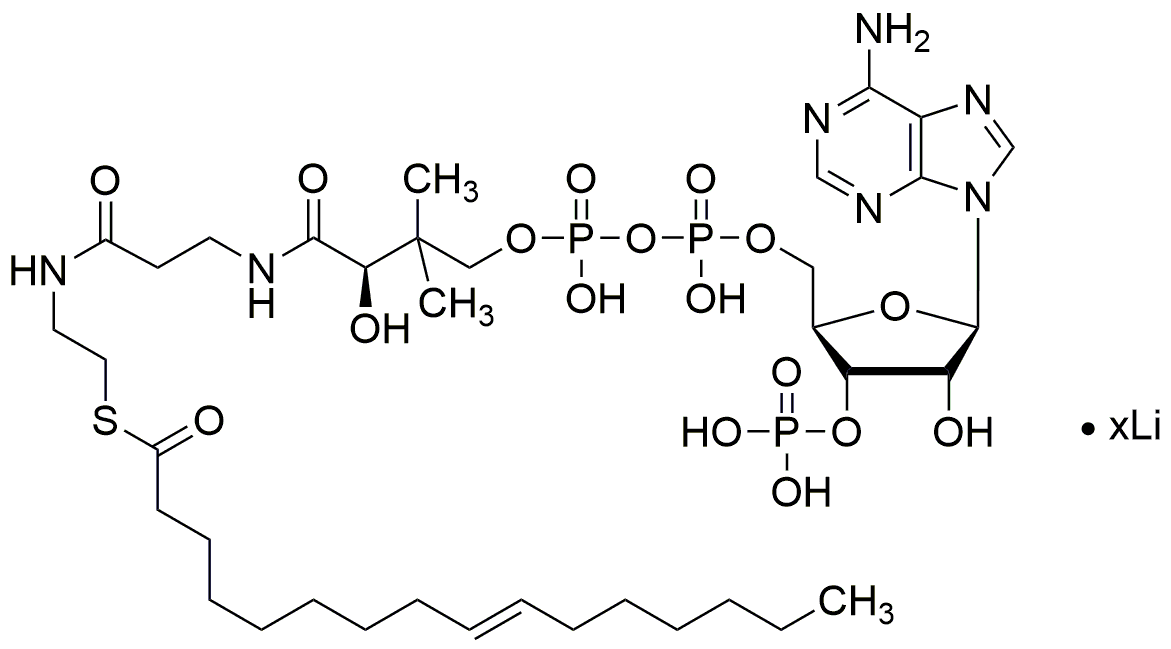Palmitoleoyl coenzyme A lithium salt is widely utilized in research focused on:
- Metabolic Studies: This compound plays a crucial role in studying lipid metabolism and energy production in cells, helping researchers understand metabolic disorders.
- Biochemical Pathways: It is used to investigate fatty acid synthesis and degradation pathways, providing insights into how cells utilize fats for energy.
- Pharmaceutical Development: The compound serves as a valuable tool in drug formulation, particularly in developing therapies targeting metabolic diseases and obesity.
- Cell Culture Applications: In laboratory settings, it is employed to enhance the growth and differentiation of specific cell types, aiding in tissue engineering and regenerative medicine.
- Nutrition Research: This chemical is important in studies examining the effects of dietary fats on health, contributing to the development of nutritional guidelines and interventions.
General Information
Properties
Safety and Regulations
Applications
Palmitoleoyl coenzyme A lithium salt is widely utilized in research focused on:
- Metabolic Studies: This compound plays a crucial role in studying lipid metabolism and energy production in cells, helping researchers understand metabolic disorders.
- Biochemical Pathways: It is used to investigate fatty acid synthesis and degradation pathways, providing insights into how cells utilize fats for energy.
- Pharmaceutical Development: The compound serves as a valuable tool in drug formulation, particularly in developing therapies targeting metabolic diseases and obesity.
- Cell Culture Applications: In laboratory settings, it is employed to enhance the growth and differentiation of specific cell types, aiding in tissue engineering and regenerative medicine.
- Nutrition Research: This chemical is important in studies examining the effects of dietary fats on health, contributing to the development of nutritional guidelines and interventions.
Documents
Safety Data Sheets (SDS)
The SDS provides comprehensive safety information on handling, storage, and disposal of the product.
Product Specification (PS)
The PS provides a comprehensive breakdown of the product’s properties, including chemical composition, physical state, purity, and storage requirements. It also details acceptable quality ranges and the product's intended applications.
Certificates of Analysis (COA)
Search for Certificates of Analysis (COA) by entering the products Lot Number. Lot and Batch Numbers can be found on a product’s label following the words ‘Lot’ or ‘Batch’.
*Catalog Number
*Lot Number
Certificates Of Origin (COO)
This COO confirms the country where the product was manufactured, and also details the materials and components used in it and whether it is derived from natural, synthetic, or other specific sources. This certificate may be required for customs, trade, and regulatory compliance.
*Catalog Number
*Lot Number
Safety Data Sheets (SDS)
The SDS provides comprehensive safety information on handling, storage, and disposal of the product.
DownloadProduct Specification (PS)
The PS provides a comprehensive breakdown of the product’s properties, including chemical composition, physical state, purity, and storage requirements. It also details acceptable quality ranges and the product's intended applications.
DownloadCertificates of Analysis (COA)
Search for Certificates of Analysis (COA) by entering the products Lot Number. Lot and Batch Numbers can be found on a product’s label following the words ‘Lot’ or ‘Batch’.
*Catalog Number
*Lot Number
Certificates Of Origin (COO)
This COO confirms the country where the product was manufactured, and also details the materials and components used in it and whether it is derived from natural, synthetic, or other specific sources. This certificate may be required for customs, trade, and regulatory compliance.


